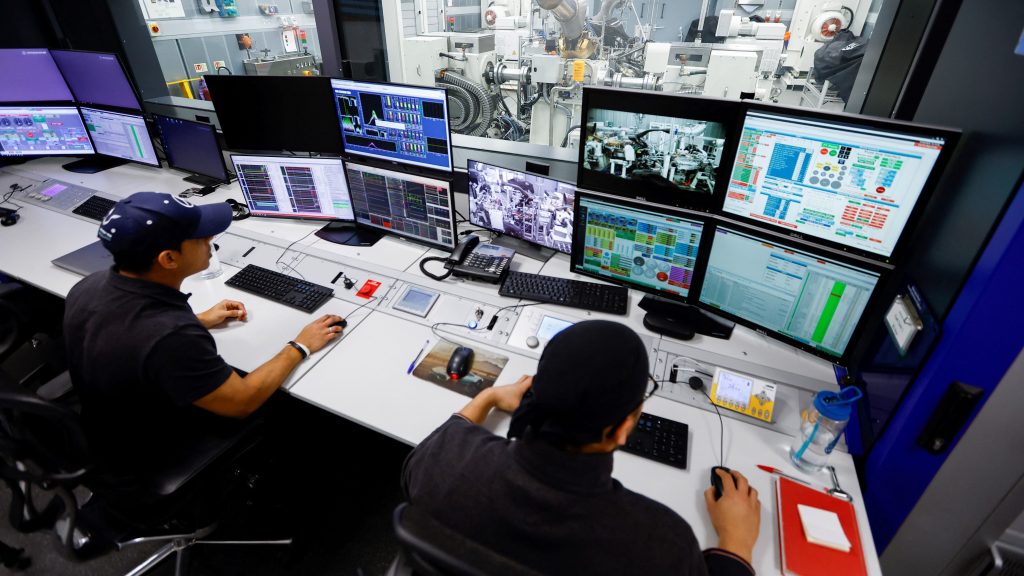In Race For Efficient EVs, Mercedes Taps F1 Team To Keep Up With Tesla

Mercedes-Benz has plugged its Formula One team into the engineering process to build vastly more efficient mass-market electric vehicles (EVs), slashing development times by a quarter or more as it jump starts efforts to keep pace with Tesla.
F1 technology has always eventually bled over into mass-market vehicles. But Mercedes’ F1 collaboration to build more efficient EVs faster is unprecedented because it embeds that racing mindset and technological expertise directly in product development.
After decades of leadership in combustion-engine technology, legacy carmakers like Mercedes have lagged Tesla in electric vehicles. Mercedes’ F1 team can help it get back in the race, said Steven Merkt, head of transportation solutions at TE Connectivity, a major autos supplier.
“Nobody feels the pressure more than Mercedes to be innovation leaders here,” Merkt said. “They’ve got to push it out or they’re no longer Mercedes.”
Last year, Mercedes unveiled its EQXX concept car, a super-efficient EV capable of a range of more than 1,200 km (745 miles), which was jointly developed with the German premium carmaker’s F1 team in England.
The EQXX took just 18 months to develop, leaning on the F1 team’s experience of working rapidly to squeeze efficiency from engines and electric motors, aerodynamics and rolling resistance, the company said.
“We have an edge here with Formula One that others don’t have,” Mercedes Chief Technology Officer Markus Schaefer said. “Tesla doesn’t have it. Other teams don’t have it.”
Tesla did not respond to a request for comment.
Speed is ever more important because newer entrants, above all Tesla, can develop or tweak models far more quickly than legacy carmakers. Fast-moving Chinese EV makers have cut development time to an average of 2.5 years and are launching innovative, cheaper models in Europe.
The need for speed is coupled with a push among carmakers to make EVs more efficient and thereby reduce costs – by lowering weight, improving range, and using less battery materials already in short supply. Suppliers say efficiency is now baked into some EV contracts as carmakers seek to make their vehicles more affordable.
“Efficiency is a key enabler to accelerate adoption of EVs globally,” Schaefer said.
Parts of what Mercedes learned from the EQXX will feature in a new EV platform that will go into production in 2024, including aerodynamic features, parts of the powertrain and the vehicle’s software system.
Schaefer said applying its F1 approach, Mercedes has cut new vehicle development time from an average of 58 months to go from the drawing board to mass production to “the low 40s”. For derivative models – similar models built using the same platform – the target is “the low 30s”.
The F1 engine team at Mercedes AMG High Performance Powertrains (HPP) in Brixworth in central England is now working on at least half a dozen new projects developing parts for mass-market Mercedes models – batteries, invertors and new generations of motors, Schaefer said.
‘READY FOR THE NEXT RACE’
HPP advanced technology director Adam Allsopp said he took the call from Mercedes headquarters in Stuttgart that kickstarted the EQXX project standing in a former cowshed while on holiday on the Isle of Wight in August 2020. It came with a clear, tough challenge – build an EV capable of driving 1,000 km on a single charge.
F1 fuel limits imposed in 2014 forced HPP to develop engines and cars that squeeze the most out of every drop and to “chase every single watt of loss” from two electric motors, Allsopp said.
“A fundamental part of who we are is always getting ready for the next race,” Allsopp said.
Applying that racing mindset, F1 engineers in Brixworth and nearby Brackley worked with a team in Stuttgart to produce the EQXX – using a flexible approach that allowed the team to move forward with development before the EV’s batteries were ready and then adapt plans when they were.
The EQXX featured a battery pack half the size of Mercedes’ flagship EQS SUV, compact electronics hardware and new operating system. Coupled with sleek aerodynamics, that allowed it to drive more than 1,200 km from Stuttgart to Silverstone in England on a single charge, spending 8.3 kilowatt hours (kWh) of energy per 100 km.
By comparison, Tesla says its long-range Model 3 spends 16 kWh per 100 km.
To maintain speed for bringing elements of the EQXX to mass production in 2024 on its new compact Mercedes Modular Architecture (MMA) vehicle platform, the German carmaker has developed a digital model of its plant in Rastatt – the same car will also be built in Hungary and China – to “simulate the assembly process,” and thus accelerate the physical changeover of the plant to build the new EVs, CTO Schaefer said.
Traditionally, carmakers have conducted “mid-life” upgrades on vehicle models after three or four years, but Schaefer said “updates to EVs will be way more frequent.”
‘NAME OF THE GAME’ IS EFFICIENCY
Others in the auto industry are also ramping up the race for speed and efficiency.
Ford Motor Co has announced plans to follow Mercedes with a return to F1 racing in 2026, providing “an incredibly cost-effective platform to innovate, share ideas and technologies,” CEO Jim Farley said in February.
And Volkswagen has said it aims to cut its time to market for new Chinese models from four years to closer to the Chinese 2.5-year average, partly by localizing more research and development.
Carmakers are so focused on efficiency some now include penalties for suppliers who fail to meet efficiency targets, said Liam Butterworth, CEO of supplier Dowlais, whose sideshafts are used in nine of the world’s top ten selling EVs.
OneD Battery Sciences adds silicon to EV battery anodes that cut weight, reduce cost and charge batteries faster. General Motors has invested in the Palo Alto, California-based company and is researching using the technology in the U.S. carmaker’s Ultium batteries, both companies said.
OneD CEO Vincent Pluvinage said that during the second quarter the company will announce more agreements with carmakers seeking cheaper, more efficient EVs. He declined to provide further details of the deals.
“Increasing performance and reducing costs is the name of the game,” Pluvinage said. “If you have a technology that works but you’re asking a premium, carmakers are no longer interested.”
So far, carmakers have added more batteries to vehicles to increase EV range, exacerbating a looming shortage of raw materials such as lithium and cobalt. But HPP’s Allsopp said making EVs more efficient allows carmakers to use smaller batteries, making them both greener and cheaper.
“Just throwing batteries at something is not an intelligent solution,” Allsopp said. “If you find clever ways to achieve the same range: it’s better for customers, carmakers and the planet.”
(Reporting By Nick Carey, editing by Ben Klayman and Daniel Flynn)




